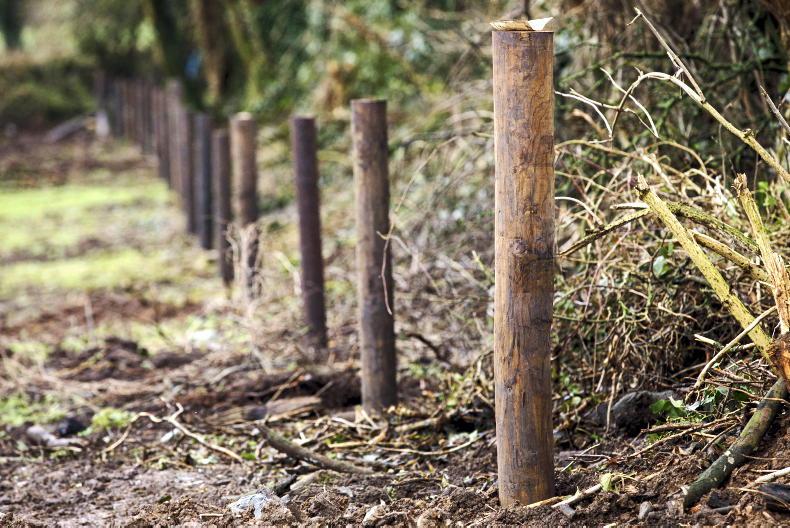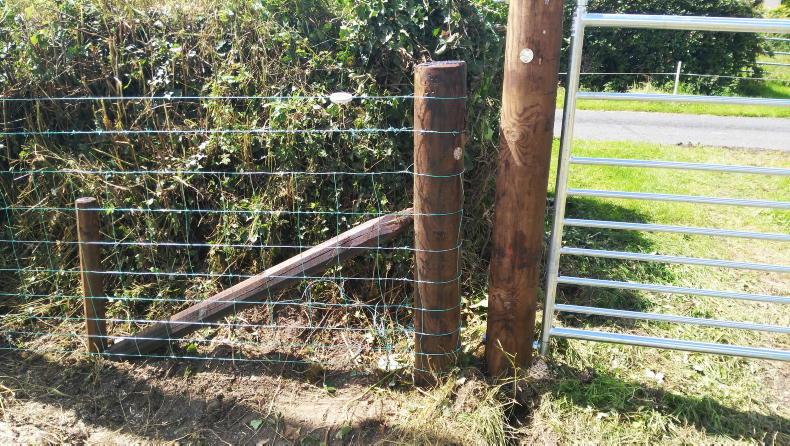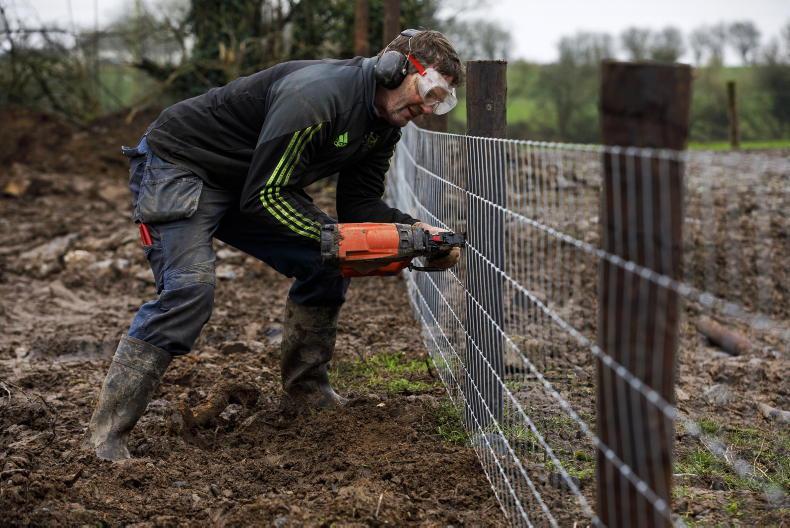The banning of creosote as a preservative of timber fencing for agricultural and domestic use in April 2023 was regarded by many as a step backwards in creating long-life fencing.
Creosote was long seen as the gold standard in preservation of fencing for damp Irish conditions, with reasonable pricing associated with the long-life posts.
While increases during inflation did affect timber prices, the overall effect on posts costs was acceptable.
Alternatives
However, since then, the cost of alternatives to creosote posts that have received Department of Agriculture approval has exceeded that of creosote posts considerably in many, but not all, cases.
The Irish Farmers Journal has been contacted by several farmers in recent weeks who have been completing works under TAMS III with regard to fencing costs, with reference costs falling short of labour and materials costs by roughly 20%.
Sheep fencing specifications
Strainer posts must be at least 2.1m (7ft) long with a minimum diameter of 175mm (7in) and driven at least 900mm (3ft) into the ground.
It is required to erect a strainer “at the beginning and end of every length of fencing, at gaps or openings, at every change of direction where the angle is greater than 30 degrees and to accommodate any significant change in gradient”.
Intermediate posts are required to be at least 1,800mm (6ft) long and a minimum of 100mm (4in) diameter and shall be driven at least 600mm (2ft) into the ground. Intermediate posts shall be spaced at no more than 5m intervals.
For the use of sheep wire combined with one line of barbed wire, the fence shall have a minimum height of 1,000mm, with the barbed wire set above the sheep mesh.The lowest line of the sheep mesh shall be between 50mm and 100mm above ground level.
Some farmers question if there is separate specification for mountain v lowland fencing.
There is actually no difference in the specifications of mountain and lowland sheep fencing; the increased payment given towards mountain sheep fencing (€8.81/linear m v €6.75/m) is due to the increased labour associated with working on the difficult terrain.
Taking this specification into consideration, we can take a price on TAMS spec sheep fencing.
After researching prices of TAMS spec (meeting NSAI requirements), we found 6ft (1,800mm) x 4in (100mm) posts for sale from merchants from as low as €6.80/post plus VAT right up to €14.70/post plus VAT; over double the price.

The ban on creosote has left farmers in a quandary regarding long life and cost-effective fence posts. \ Donal O'Leary
Straining posts are a similar tale; we received quotes of €21.30/post right up to €33.74 plus VAT.
The 100m rolls of high-tensile sheep wire eligible for grant aid came to between €150 and €189.92 plus VAT, with 200m rolls of barbed wire priced at €52.84 plus VAT, while high-tensile electric wire clocks in at €60.92 per roll (sold on weight, not length). For added measure, a 200-pack of staples will set you back €16 plus VAT.
Case study one: cheap and cheerful
It’s a bit tongue in cheek to say “cheap and cheerful” but we will use the lower price on all items as an example. Our sample distance is 500m. This will require six straining posts, placing one every 100m from start to end.
Using a spacing of one intermediate post every 4m (1m less than minimum) will require 120 posts. Five rolls of sheep wire, two and a half rolls of barbed wire and one roll of high-tensile electric wire will all be required.
Case study two: no expense spared
If we go the other end of the scale price wise, costs increase dramatically. While the above cheaper options all qualified under NSAI and Department standards, it is worth noting that they did this but no more.
NSAI standards require a guarantee of 15 years’ working life, which the cheaper option gave, but the more expensive option listed gave a guarantee of 25 years with a life expectancy of 35 to 40 years.
Difference v
reference costs
The difference between both the cheapest and dearest is staggering; €1,217.63 for the 500m run, or €243.52/100mm. The majority of this price increase is attributed to the cost of the more expensive intermediate posts with a differential of €948 between cheap and expensive.
Reference costs for lowland sheep fencing come to €6.80/m plus VAT. For the 500m run of fencing above, our reference cost would be €3,400 plus VAT.
This appears to amply cover both the expensive and cheaper options, but we have omitted labour costs with both.
Taking a labour cost of €2/m, we can add an additional €1,000 on to each of the case studies. While the reference cost will still cover cheaper options, it will fall far short of covering the higher-end products to the tune of €784.46, or roughly 23%.
It is also worth noting that we have been on the lighter side regarding straining posts every 100m.
We could easily add another five straining posts to the list, which will add an additional €202.44 to our bill.
Reference costs out of touch
with high-end products
Fencing is a task few enjoy, but less people enjoy stock breaking out of paddocks, so when it comes to doing a new fence, farmers will generally opt towards high-end products to try to extend the working life of the fence.
With all the talk of sustainability, it makes sense to use posts that have an extended lifespan and will require replacement less often, but if reference costs are so out of kilter with actual costs that they barely cover materials, let alone labour, then the fear would be that more farmers would use lesser-quality materials.
The banning of creosote has caused farm fence post costs to spiral.High-end posts with a 25-year guarantee are costing up to €15/post, nearly double that of older creosote posts.Our analysis show that where top-end materials are used, the reference costs covers no labour costs.
The banning of creosote as a preservative of timber fencing for agricultural and domestic use in April 2023 was regarded by many as a step backwards in creating long-life fencing.
Creosote was long seen as the gold standard in preservation of fencing for damp Irish conditions, with reasonable pricing associated with the long-life posts.
While increases during inflation did affect timber prices, the overall effect on posts costs was acceptable.
Alternatives
However, since then, the cost of alternatives to creosote posts that have received Department of Agriculture approval has exceeded that of creosote posts considerably in many, but not all, cases.
The Irish Farmers Journal has been contacted by several farmers in recent weeks who have been completing works under TAMS III with regard to fencing costs, with reference costs falling short of labour and materials costs by roughly 20%.
Sheep fencing specifications
Strainer posts must be at least 2.1m (7ft) long with a minimum diameter of 175mm (7in) and driven at least 900mm (3ft) into the ground.
It is required to erect a strainer “at the beginning and end of every length of fencing, at gaps or openings, at every change of direction where the angle is greater than 30 degrees and to accommodate any significant change in gradient”.
Intermediate posts are required to be at least 1,800mm (6ft) long and a minimum of 100mm (4in) diameter and shall be driven at least 600mm (2ft) into the ground. Intermediate posts shall be spaced at no more than 5m intervals.
For the use of sheep wire combined with one line of barbed wire, the fence shall have a minimum height of 1,000mm, with the barbed wire set above the sheep mesh.The lowest line of the sheep mesh shall be between 50mm and 100mm above ground level.
Some farmers question if there is separate specification for mountain v lowland fencing.
There is actually no difference in the specifications of mountain and lowland sheep fencing; the increased payment given towards mountain sheep fencing (€8.81/linear m v €6.75/m) is due to the increased labour associated with working on the difficult terrain.
Taking this specification into consideration, we can take a price on TAMS spec sheep fencing.
After researching prices of TAMS spec (meeting NSAI requirements), we found 6ft (1,800mm) x 4in (100mm) posts for sale from merchants from as low as €6.80/post plus VAT right up to €14.70/post plus VAT; over double the price.

The ban on creosote has left farmers in a quandary regarding long life and cost-effective fence posts. \ Donal O'Leary
Straining posts are a similar tale; we received quotes of €21.30/post right up to €33.74 plus VAT.
The 100m rolls of high-tensile sheep wire eligible for grant aid came to between €150 and €189.92 plus VAT, with 200m rolls of barbed wire priced at €52.84 plus VAT, while high-tensile electric wire clocks in at €60.92 per roll (sold on weight, not length). For added measure, a 200-pack of staples will set you back €16 plus VAT.
Case study one: cheap and cheerful
It’s a bit tongue in cheek to say “cheap and cheerful” but we will use the lower price on all items as an example. Our sample distance is 500m. This will require six straining posts, placing one every 100m from start to end.
Using a spacing of one intermediate post every 4m (1m less than minimum) will require 120 posts. Five rolls of sheep wire, two and a half rolls of barbed wire and one roll of high-tensile electric wire will all be required.
Case study two: no expense spared
If we go the other end of the scale price wise, costs increase dramatically. While the above cheaper options all qualified under NSAI and Department standards, it is worth noting that they did this but no more.
NSAI standards require a guarantee of 15 years’ working life, which the cheaper option gave, but the more expensive option listed gave a guarantee of 25 years with a life expectancy of 35 to 40 years.
Difference v
reference costs
The difference between both the cheapest and dearest is staggering; €1,217.63 for the 500m run, or €243.52/100mm. The majority of this price increase is attributed to the cost of the more expensive intermediate posts with a differential of €948 between cheap and expensive.
Reference costs for lowland sheep fencing come to €6.80/m plus VAT. For the 500m run of fencing above, our reference cost would be €3,400 plus VAT.
This appears to amply cover both the expensive and cheaper options, but we have omitted labour costs with both.
Taking a labour cost of €2/m, we can add an additional €1,000 on to each of the case studies. While the reference cost will still cover cheaper options, it will fall far short of covering the higher-end products to the tune of €784.46, or roughly 23%.
It is also worth noting that we have been on the lighter side regarding straining posts every 100m.
We could easily add another five straining posts to the list, which will add an additional €202.44 to our bill.
Reference costs out of touch
with high-end products
Fencing is a task few enjoy, but less people enjoy stock breaking out of paddocks, so when it comes to doing a new fence, farmers will generally opt towards high-end products to try to extend the working life of the fence.
With all the talk of sustainability, it makes sense to use posts that have an extended lifespan and will require replacement less often, but if reference costs are so out of kilter with actual costs that they barely cover materials, let alone labour, then the fear would be that more farmers would use lesser-quality materials.
The banning of creosote has caused farm fence post costs to spiral.High-end posts with a 25-year guarantee are costing up to €15/post, nearly double that of older creosote posts.Our analysis show that where top-end materials are used, the reference costs covers no labour costs.










SHARING OPTIONS